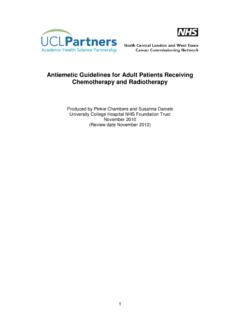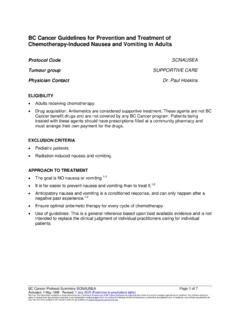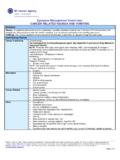Transcription of Optimal Management of Chemotherapy-induced …
1 Optimal Management of Chemotherapy-induced nausea and Vomiting (CINV). Udomsak Bunworasate Chulalongkorn University Scope of the Problem Classification of CINV. Acute Occurring within the first 24 hrs. after initiation of chemo;. generally peaks after 5 to 6 hrs. Delayed Occurring from 24 hrs. to several days (days 2 to 5) after chemo (commonly seen with cisplatin, carboplatin, cyclophosphamide, ifosfamide, doxorubicin). Anticipatory Occurring before a treatment as a conditioned response to the occurrence of CINV in previous cycles Breakthrough Occurring despite appropriate prophylactic treatment Refractory Recurring in subsequent cycles of therapy, excluding anticipatory CINV.
2 , M Aapro. NEJM 2016. Patterns of CINV. Cisplatin Cyclophosphamide/Carboplatin Intensity of emesis 0 1 2 3 4 5. Days Martin M. Oncology. 1996;53(suppl 1): 26 31. PERCEPTIONS versus EVIDENCE. - Underestimation of Emesis with chemotherapy - 100 MD/RN prediction 80 Patient experience Percent of Patients 60 52. 40 34 35. 28. 24. 20 17 13 15. 0. Acute Acute Delayed Delayed nausea Vomiting nausea Vomiting Physicians and nurses from 14 oncology practices in 6 countries Patients: 75% women; 78% Mod emetic chemo; 50% breast cancer; 18% lung cancer Grunberg et al. (2004). Cancer, 100, 261-268.
3 CINV prevention from the start Uncontrolled CINV in the previous cycle is the key factor for CINV in the subsequent cycle, increasing the likelihood of CINV. by times in Cycle 2 and 14 times in Cycle 3. Patients at high risk of CINV need effective prevention from the start. Molassiotis A, et al. J Pain Symptom Manage. 2016 Feb 16. Risk Factors of CINV. Patient-related risk factors:1. Younger age (<60 years). Female gender No/minimal prior history of alcohol and tobacco use Susceptibility to motion sickness Prior CINV*. Anxiety Treatment-related risk factors:1,2. Moderate-to-high emetogenicity of chemotherapy agents or regimens Use of moderate-to-high drug dose and multiple agents 1.
4 Gregory RE, et al. Drugs. 1998;55:173 189. 2. Hesketh PJ, et al. J Clin Oncol. 1997;15:103 109. Physiology of CINV. Grunberg SM, et al. N Engl J ;329:1790 1796. Neurotransmitters involved in the Emetic Reflex Histamine Cannabinoids GABA Endorphins Emetic Reflex Dopamine Acetylcholine DA RAs Substance P Serotonin NK1 RAs 5-HT3 RAs Adapted from: Navari RM. Drugs. 2013;73:249 262. Frame DG. J Support Oncol. 2010 Mar-Apr;8(2 Suppl 1):5-9. Lorusso V et al. Future Oncol. 2014 Oct 31:1-13. DA: dopamine; GABA: gamma-aminobutyric acid; NK1: neurokinin-1 RAs: receptor antagonists; 5-HT3: 5-hydroxytryptamine3.
5 Antiemetics Available for CINV. Most commonly used classes of antiemetics 5-HT3 Receptor Antagonists (ondansetron, dolasetron, granisetron, palonosetron). Inhibit serotonin, 5-HT3, mediated activation of the vagal afferent fibres in the stomach and the central CTZ and vomiting centres through the 5-HT3 receptor Corticosteroids (dexamethasone). Unknown mechanism but increase the 5-HT3 RA. antiemetic efficacy NK1 Receptor Antagonists (aprepitant, fosaprepitant). Inhibition of the substance P-mediated activation of the vomiting centre Other agents Other Neurotransmitters, Receptors, and Drugs Antiemetic Risk Groups Antiemetic Risk Percentage of Patients (%).
6 Groups High 90% or more of patients experience acute emesis Moderate 30% to 90% of patients experience acute emesis Low 10% to 30% of patients experience acute emesis Minimal < 10% of patients experience acute emesis Specific antiemetic regimen recommended for each antiemetic risk group Aapro M, Gralla RJ, Herrstedt J, et al. MASCC/ESMO antiemetic guideline 2016. Multinational Association of Supportive Care in Cancer. 2016. Available at Accessed on April 6, 2016. Emetic Risk Categories (examples). High Cyclophosphamide/doxorubicin combination Cisplatin, carboplatin AUC 4.
7 Dacarbazine High doses chemotherapy agents (HDCy, HDIfos, Transplant). Moderate IV Alkylaing agents Anthracyclines (< 60 mg/m2). Azacitidine, bendamustine ARA-C > 200 mg/m2, MTX 250 mg/m2. Low Antimetabolites Minimal Monoclonal antibodies, vinca alkaloids, bortezomib, -nibs Grunberg SM, et al. Support Care Cancer. 2011;19 (Suppl 1):S43-7. Prophylaxis for CINV: General Principles Acute Typically administered IV in the infusion center Delayed Some IV drugs will cover delayed (eg. Palonosetron). May receive prescription to take as scheduled Breakthrough Should always receive a prescription that is PRN.
8 Use a different MOA than for prophylaxis Anticipatory Lorazepam if fearful or poor control after previous cycle Grunberg SM, et al. Support Care Cancer. 2011;19 (Suppl 1):S43-7. Overview of NCCN / ASCO / MASCC-ESMO guidelines for Acute nausea and vomiting Emetic risk groups Antiemetics High (non-AC) 5-HT3 RA + DEX + NK1 RA + OLA*. High: anthracycline +. cyclophosphamide (AC)a 5-HT3 RA + DEX + NK1 RA + OLA*. Carboplatinb 5-HT3 RA + DEX + NK1 RA. Moderatec 5-HT3 RAd + DEX. Low 5-HT3 RA OR DEX OR DRAe 5-HT3 RA = DRA =. DEX = NK1 RA= neurokinin 1 PALO = OLA =. serotonin receptor dopamine receptor dexamethasone receptor antagonist palonosetron Olanzapina antagonist antagonist * The addition of OLA is recommended in HEC by ASCO, is one possible option in HEC and MEC by NCCN and only when nausea is an issue by MASCC/ESMO.
9 A If an NK1 RA is not available for AC chemotherapy , palonosetron is the preferred 5-HT3 RA for MASCC/ESMO. b Carboplatin is considered as high-MEC by ASCO (here only AUC > 4) and MASCC/ESMO, and reclassified as HEC by NCCN (when AUC >4): an NK1 RA. should be added in all cases. c An NK1 RA is recommended as option in MEC for selected patients with additional risk factors or who have failed previous therapy with 5-HT3 antagonist plus steroid by NCCN. d Palonosetron and granisetron extended-release injection formulation are the preferred 5-HT3 RAs in MEC regimens without an NK1 RA by NCCN.
10 E Not for ASCO. 1. Roila F. et al. Ann Oncol. 2016 Sep;27(suppl 5):v119-v133. MASCC/ESMO Antiemetic Guideline 2016 Available at: ; 2. NCCN: National Comprehensive Cancer Network; NCCN Clinical Practice Guidelines in Oncology; Version Available at: ; 3. Hesketh P. J. et al. J Clin Oncol. 2017 Oct 1;35(28):3240-3261. doi: Epub 2017 Jul 31. Overview of NCCN / ASCO / MASCC-ESMO guidelines for Delayed nausea and vomiting Emetic risk groups Antiemetics High (non-AC) NK1 RAa + DEX + OLA*. High: anthracycline + + DEX**. cyclophosphamide (AC). NK1 RAa + OLA*. Carboplatinb NK1 RAa + OLA ?










